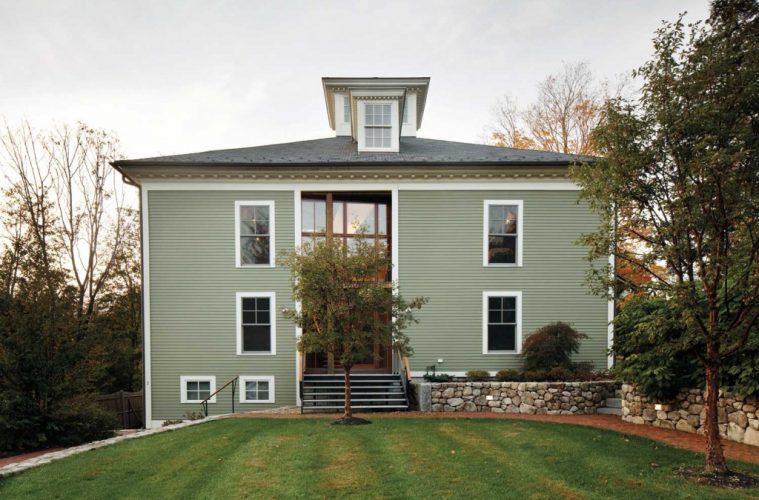When this Newburyport homeowner attends a concert of the local chamber music ensemble, he strolls out his back door and follows a curving red brick path that winds through terraced gardens, past a Neoclassical pergola. The path leads to a door that opens into a tall clapboard building crowned with a cupola. Inside, the old world sensibility of the façade gives way to drama, light, and vaulting space.
Framed with original beams darkened with age, with floors negotiated via steel and bowed-ash stairs, whose bamboo treads appear to float in space, and featuring vast swaths of light reflected by taut white sails, the interior of this 1850 carriage house is nothing short of dazzling. When a string quartet gathered in one corner of the ground floor begins to play, the rapt audience finds that the acoustics are extraordinary. The atmosphere is magical.
“The lot occupied by this building was threatened with development,” says the owner of the carriage house, which serves as a concert hall tonight. “This would have been torn down. More than anything, we wanted to make sure that didn’t happen.”
He and his wife, owners of one of the imposing Federal manses for which Newburyport is famous, bought the property, thus saving it from demolition. In the process, they also saved the surrounding neighborhood, a lightly settled lane just off a busy city street.
Old carriage house are like old barns; they are stout workhorses in service to a technology long gone. Sometimes they become garages, their façades cut up with awkward entries for cars, while much of the tall space required by horses and carriages stands unused. Eventually, decay sets in, and another reminder of New England’s rural past becomes a liability that is razed and soon forgotten.
Thus, when this couple bought and restored an architecturally imposing mid-19th-century carriage house and made it available to the community, they performed public services on many levels. The irony: The carriage house they saved does not accompany their own grand house; it once served the house next door. It all represents the 100-year-old American trend of splitting up big estates, their outbuildings, and their land into many smaller lots. The process continues, as it has threatened to here in Newburyport.
“When they came to me, they didn’t just bring the question of what to do with this big, barn-like structure,” says Newburyport architect Andrew Sidford, whose innovative hand is evident throughout the Newbury-Plum Island-Newburyport area. “They also asked how I was going to bring together their house, its long garden, the carriage house behind the house next door, give them some parking, and make it all look wonderful.”
“We knew lots of people who knew [Sidford], and we were involved in some of the same local causes,” says the lady of the house. “We had seen his work and liked it. But what Andy did at our church, Newburyport’s First Unitarian, was so wonderful that we hired him on the strength of that.”
When Sidford created interior parking, two eminently rentable apartments, an aerie with a poetic view, a spectacular private concert hall, and then gracefully connected the disparate parts, he did it with curves. His brick driveway and walkways lure you toward enticing views just past the next bend; walking or driving to and from the main house and carriage house is easy and natural, the instinctive thing to do. At the terminus of a curving drive that begins at the street is the homeowners’ two-bay garage, located in a lower section of the carriage house. Along the way, a turnaround by the back door provides closer access.
The carriage house’s main entrance, however, is via a formal driveway on a perpendicular street. Here, Sidford marries the new structural elements with a new glass curtain wall that recedes at a slight angle from the massive 1850 timbers. “This way, it looks as if the front door is always open,” the homeowner says. “And we pay homage to the historic original. “I always like to say that these buildings were built like Old Ironsides,” he says, laughing.
Each project is a collaboration and evolves,” says Sidford. The entry with the glass wall is an example of that; we designed that at the homeowners’ suggestion.”
The inside features such quirky elements as a light switch fashioned from a piano’s soundboard and steel staircases with a curving ash handrail above the mundane metal one. The same curve, executed in mahogany for New England winters, crowns the exterior handrail. “There are curves everywhere,” Sidford says. “The curves on the railings refer to the curves in the sidewalk outside… I think that most modern work can be very cold. The curves soften the design.” The homeowner adds, “And they introduce a sense of play.”
Indeed, play is everywhere. As the stairs climb up into the cupola, they pause at a landing made of frosted glass. “Totally clear glass would have been a little too dramatic,” Sidford says “Even people without a fear of heights would probably get vertigo.”
While downstairs promotes conviviality, the cupola is small and meditative, far above human activity. The view, however, is vast in all directions. The interior view shows strong architectural lines and light pouring in via windows that look as though they harken back to 1850. Triangular sails act as sculptures in their own right, suspended at various points and reflecting light onto the dark joists and rafters.
Although they finished this project almost 10 years ago, the homeowners are clearly still smitten with the results. “I can recognize Andy’s work as I drive around town,” the homeowner says. “So I knew this would be pretty special.” She looks at her husband and laughs. “Still, when we hired Andy and started talking about what to do, we had no idea it would end up being this great!”

